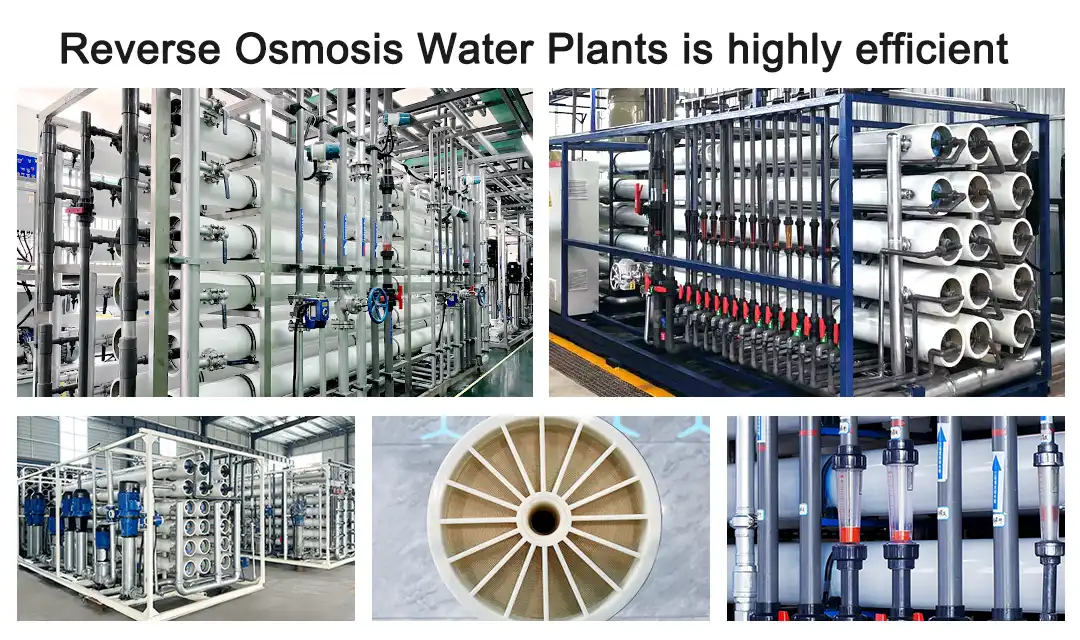RO Water Treatment Systems
Menu
Latest News
Product introduction
Introducing RO Water treatment system
The RO water treatment system is an advanced water filtration technology that uses semipermeable membranes to remove water-soluble substances such as salts, bacteria, viruses, and other impurities. When working, the water is pressurized higher than its natural osmotic pressure, driven by the high pressure pump, then forced to pass through the RO membrane; The membrane has extremely small apertures, allowing only water molecules to pass through, while blocking most pollutants from passing through. This process is known as reverse osmosis. A RO system usually consists of important parts such as preprocessing, membrane separation, high pressure pump, and posttreatment. Its output water is of high quality, can meet strict water quality standards, and is commonly used in areas such as drinking water purification, pharmaceuticals, laboratories, and industrial water. Although the creation of some wastewater containing condensed pollutants, its high efficiency filtering capabilities and relatively low energy consumption make it an indispensable technology for water resource management and conservation.
RO water treatment systems
Reverse osmosis devices usually include preprocessing (quartz sand filter, activated carbon filter, exact filter), softening equipment (if necessary), booster pumps, high pressure pumps, membrane membranes, reverse osmotic membrane elements, in-place instruments, quantitative systems, fully automatic control systems, rack platforms, etc.
1. Pretreatment systems: Typically include steps such as filtration, softening or throwing chemicals to remove suspended matter, chlorine, organic matter, and prevent membrane size.
2. High pressure pumps: Increase the water pressure enough to overcome osmotic pressure, so that water molecules travel backwards across the membrane.
Membrane composition: The core component, which only allows water molecules to pass through, and blocks the passage of most dissolved salts, bacteria and macromolecules.
4. Flow controller: Regulating the flow rate of the production of water and concentrated water, ensuring the efficiency of system operation.
5. The following storage and treatment system: includes water tanks and possible post treatment equipment, such as ultraviolet disinfection or carbon filtering, etc.
The features of RO water treatment systems
High efficiency for decontamination: Many contaminants can be removed, including dissolved salts, seeds, bacteria, and pyrogen.
High quality of output water: Rida-treated water can reach very pure levels, suitable for a variety of uses, including drinking water and industrial water.
Low energy consumption: Compared to other separation processes, the RO system requires relatively low energy during operation.
High level of automation: Modern RO systems can achieve high automation control, reduce manual operation demand, and error rate.
Little wastewater is created: although a certain amount of water will be generated, the amount of wastewater is acceptable with regard to its treatment and efficiency.
Water Treatment System RO application Area
Marine desalination: Due to its high efficiency, RO technology has occupied an important place in the global desalination sector. With this technique, the soluble salt in water can be removed and seawater can be converted into drinkable freshwater.
Industrial purification of water pure: During industrial production requires high purity water quality, such as preparation of electronic superpure water, RO technology also plays an important role. It can ensure that water quality used during production meets the strict standards.
Reusing wastewater: For industrial and urban wastewater, RO technology is also appropriate, it can help reduce environmental pollution and improve the rate of water resource recycling.
Home water purification: About home water, RO technology can remove organic substances, colloids, microorganisms and other small particles in water, and ensure safety and water hygiene in the home.
In addition, RO technology can be used in agricultural irrigation, in the food and beverage industry, and in the pharmaceutical industry for water quality treatment.
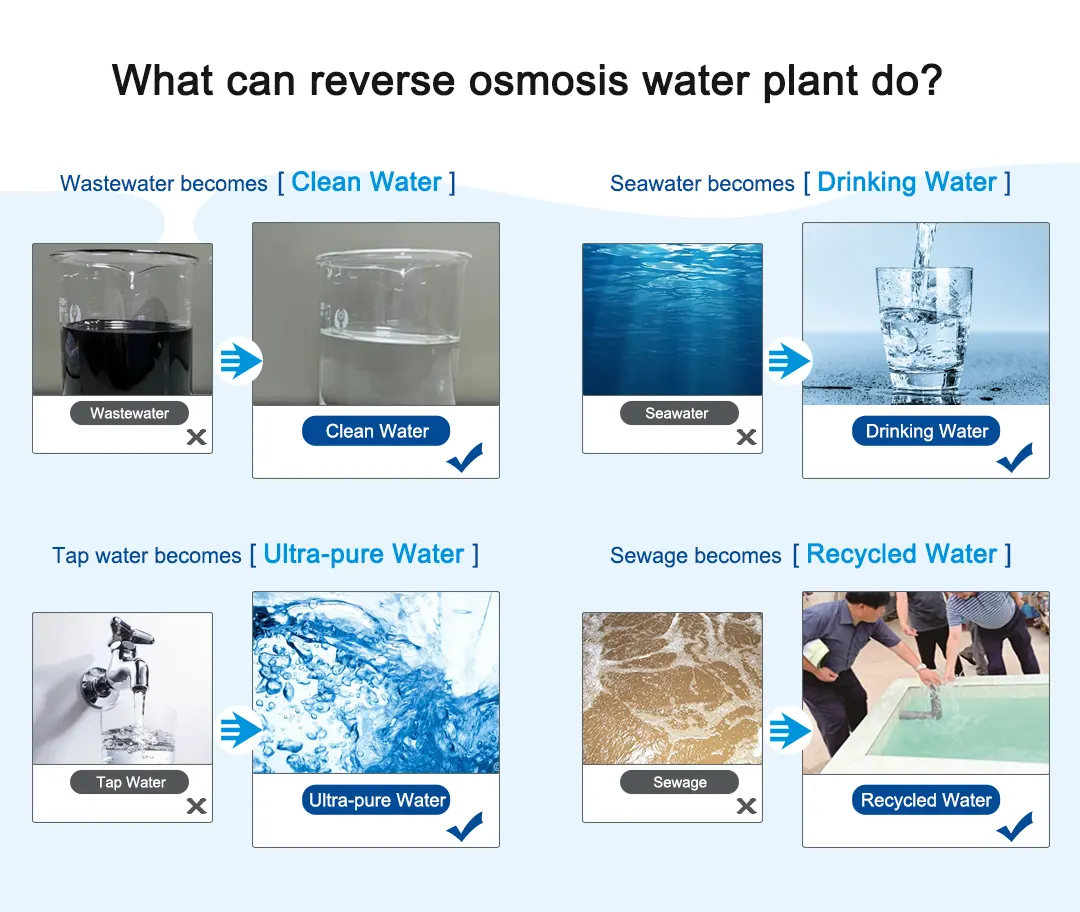
Technical principle of
RO water treatment system is a method of using semi-automatic membrane technology for the application of water purification based on the principle of osmosis phenomenon and osmosis pressure of yes of solution. In a natural condition, water molecules absorb semi-seepage from low concentration solution to high concentration solution, A process is to reduce the difference of concentration between the two sides until balancing is achieved. Ro is a artificial reverse of this process, which means by applying higher pressure than the external osmosis pressure, tying water molecules from high-concentration solution to low-concentration solution, thereby reaching the purpose of purification.
In RO water treatment system, rough water after pre-treated to eliminate suspension, chlorine and some organic substances, filled with high pressure which is higher than its osmosis pressure. High pressure water is then sent to RO membrane element with micro aperture and select transmission ability, only allows water molecules to pass through and prevent majority of soluble substances such as salt and bacteria. Therefore, when water contact RO membrane, the water molecules enter back through the membrane under the action of pressure to the pure water, while the solubility are trapped at the rough water side, producing two parts of the water flow: One side is pure water (water production) that removes contaminants and the other side is sewage (concentrated water) that contain concentrated pollution.
RO membrane is the core of the whole system and its performance affect directly the separation efficiency and operation efficiency of the system. Film selection must consider the listed ability, water flux, and its anti-pollution to different electrolytes. To maintain ro performance and extend life, the system should be regularly washed in physical or chemical to eliminate accumulated dirt and grow of creatures.
The production process of
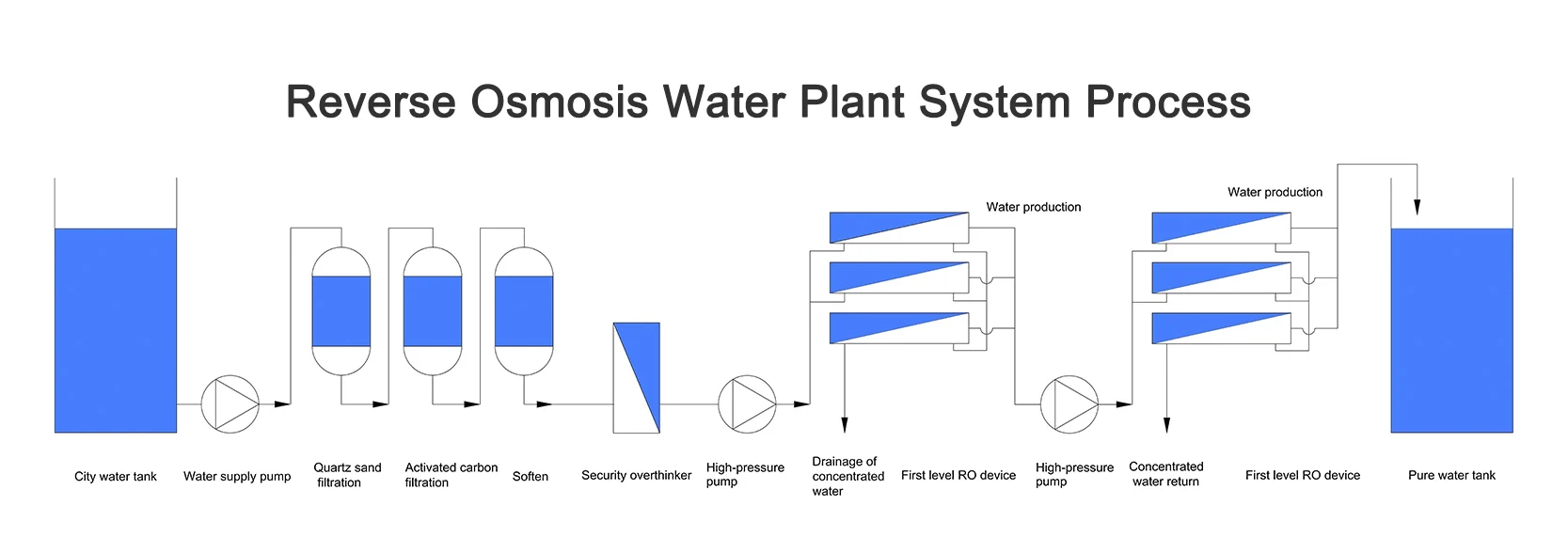
Production of equipment
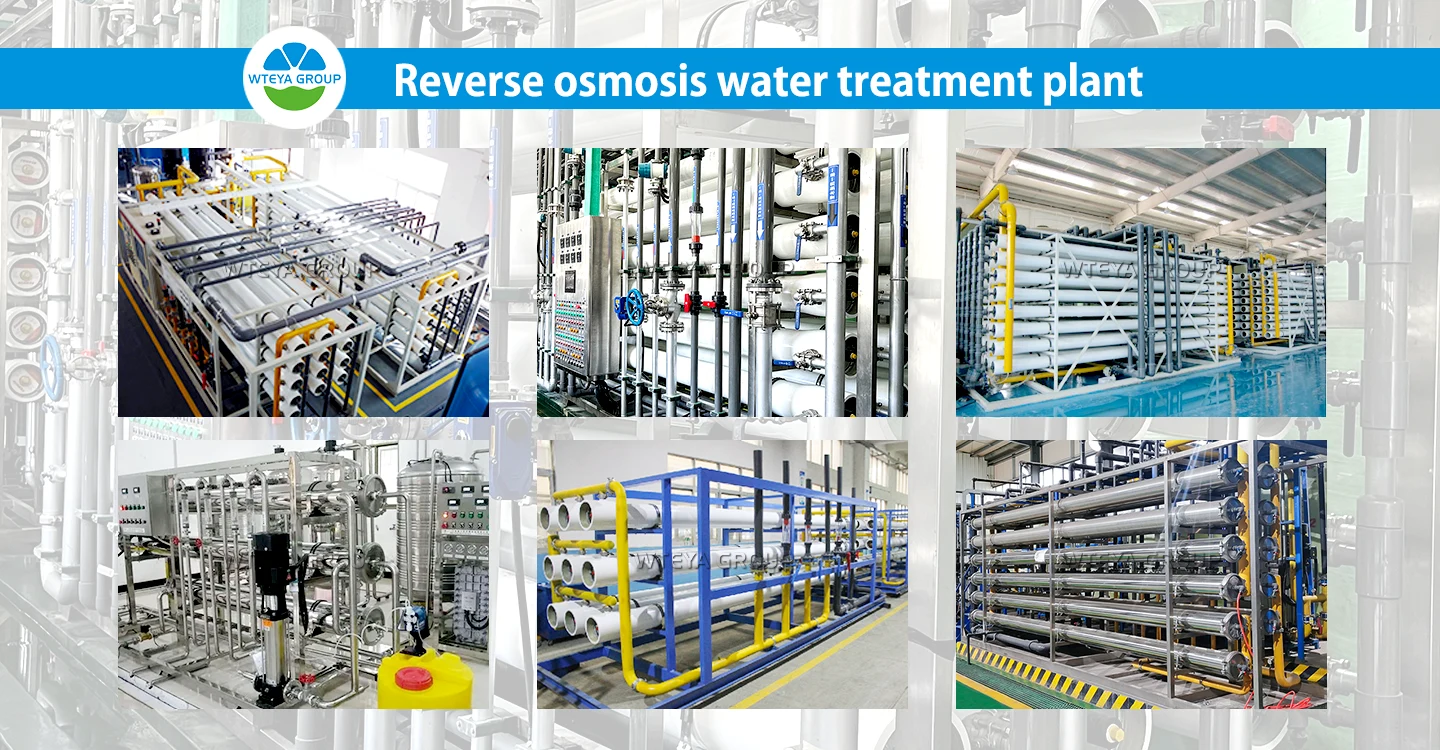
WTEYA aims to digital and intelligent production to provide superior products and services to its customers. We not only provide a wide range of standard products which are seriously tested and stable performance to meet a wide range of industrial needs. We also provide custom service, as well as OEM and ODM services, professional design team provides proper solutions for customers to meet their unique needs. We will work closely with each customer to ensure that every device suits customer's process requirements and production process accurately. WTEYA's one-stop service, innovative to create high-quality mechanical products and system solutions, professionally help customer deal with various water treatment problems.
Capacity and size
|
RO Water Treatment Plant parameter chart |
|||||
|
Cut out model |
Power rating of cloth |
Power of installation |
Water production quality |
Main machine size |
The material is made of high quality |
|
WTY-RO2-1 |
1m³/h |
5.5kw |
<5 μS/cm |
2000 × 1000 × 2000mm(H) |
304/ UPVC/ Polyamide/ |
|
WTY-RO2-2 |
2m³/h |
6.3kw |
<5 μS/cm |
2000 × 1000 × 2000mm(H) |
|
|
WTY-RO2-5 |
5m³/h |
13.2kw |
<5 μS/cm |
4500 × 2400 × 2400mm(H) |
|
|
WTY-RO2-10 |
10m³/h |
33.0kw |
<5 μS/cm |
5000 × 2600 × 2500mm(H) |
|
|
WTY-RO2-20 |
20m³/h |
67.0kw |
<5 μS/cm |
6000 × 1800 × 2800mm(H) |
|
|
8000 × 2600 × 3000mm(H) |
|||||
Chart of effect chart
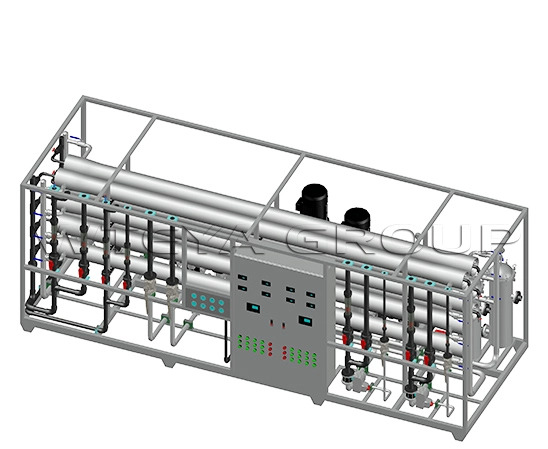
Frequently Asked Questions
Q: What is the primary purpose of RO Water Treatment Plant System?
Re: the RO Water Treatment Plant System is mainly used to eliminate water-soluble solid substances (such as salt, minerals), bacteria, virus, heavy metal and other impurities, provide high purity of water, suitable for filtration of drinking water, Pharmaceutical production, laboratory water, waste water treatment and other areas.
Q: How about different water quality treatment RO Water Treatment Plant System?
Re: the RO Water Treatment Plant System adapt to different water source scenarios and water quality by adjusting the treatment steps, such as increase the hardness of the softener to eliminate organic substances, use activated carbon filtration to eliminate organic substances, Etc.;
Q: Why does RO Water Treatment Plant System create sewage?
Re: In the RO process, part of water was pressed through the membrane while other part was not, water did not pass by the higher pollution content, this part of water is called dark water or sewage.
Q: How about the filtration rate of RO Water Treatment Plant System?
Re: the salt filtration rate refers to the percentage of salt that is removed in total salt in rough water, which is usually calculated by conductive measurement, as stated in: (1-(water conductivity/water conductivity) × 100%.
Q: How to clean and maintain RO membrane?
Re: RO membrane should be washed regularly to eliminate sedimentation and biological dirt. Cleaning methods include physical cleaning (such as Splash or circulation washing) and chemical cleaning (specific detergents use).
Q: What are the common problems of RO Water Treatment Plant System operation?
Re: Common problems include film pollution, film Damage, system pressure loss, reduce water permeability and lower waste water quality, etc.
Q: How about the energy consumption of RO Water Treatment Plant System?
Re: the energy consumption of the RO Water Treatment Plant System mostly depends on the water pressure and flow that is needed, as well as the pump efficiency in the system. High-pressure pump is the biggest energy consumption, but Ro is generally a relatively energy-saving water treatment technology.
Q: How long life of RO Water Treatment Plant System?
Re: the life of RO Water Treatment Plant System is affected by many factors, such as water quality, operating conditions, maintenance and maintenance. Usually RO membrane may need to be replaced within 3 to 5 years, but the whole system can be designed to last longer and properly maintained which can exceptionally extend service time.
Previous: Industrial Water Filtration System








